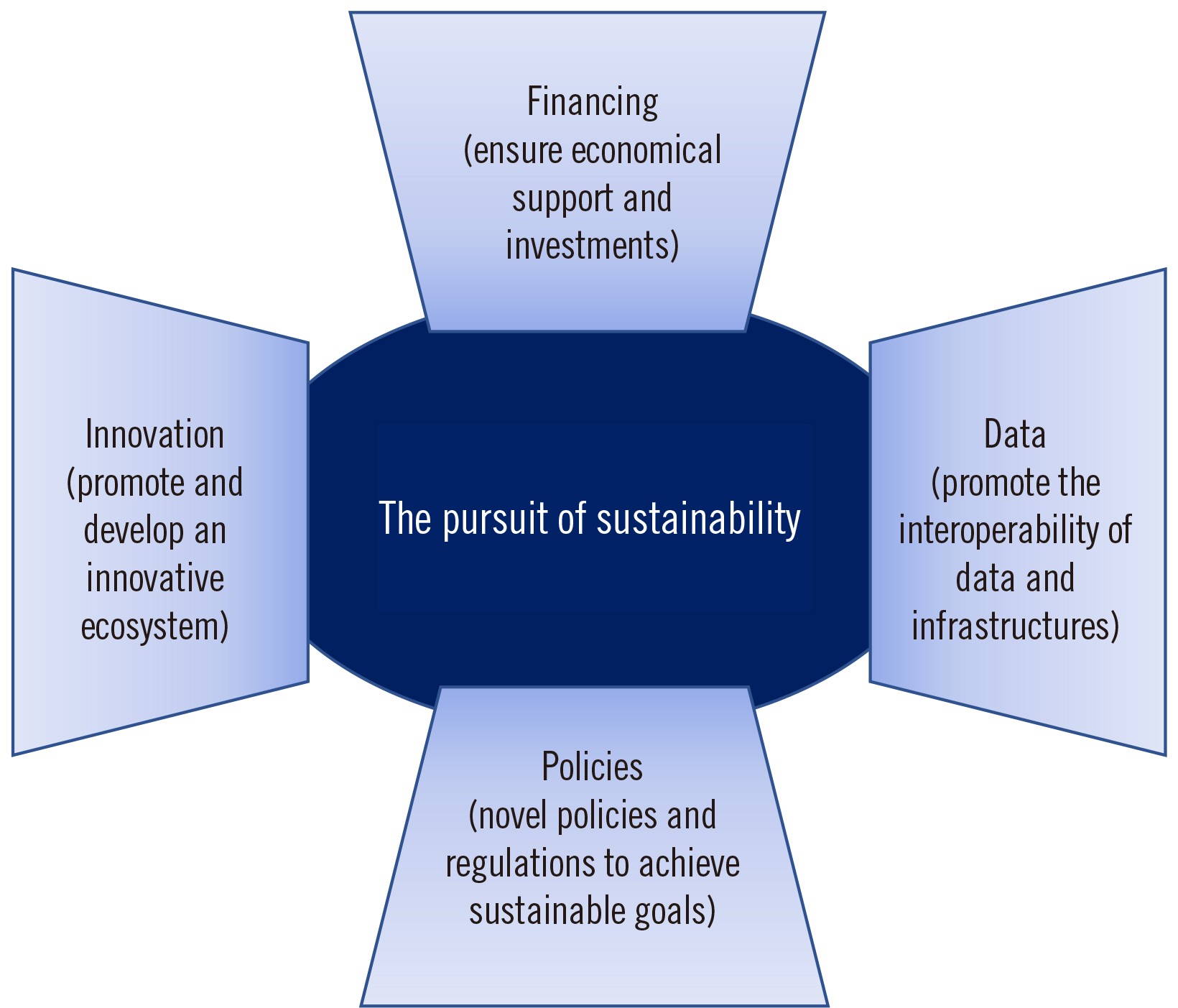Ann Lab Med.
2021 Mar;41(2):139-144. 10.3343/alm.2021.41.2.139.
Sustainability in Healthcare: Perspectives and Reflections Regarding Laboratory Medicine
- Affiliations
-
- 1Health First Europe, Brussels, Belgium
- 2European Health Management Association Brussels, Belgium
- 3Metrolab, Université Catholique de Louvain, Brussels, Belgium
- 4IFCC Committee on Mobile Health and Bioengineering in Laboratory Medicine, Milano, Italy
- 5Human Healthcare Division COFRAC (Committee Comité Français d’accréditation), Paris, France
- 6IFCC Emerging Technologies Division, Milano, Italy
- 7Department of Laboratory Medicine, Cliniques Universitaires Saint-Luc and Catholic University of Louvain, Brussels, Belgium
- KMID: 2512678
- DOI: http://doi.org/10.3343/alm.2021.41.2.139
Abstract
- Healthcare structures serve to protect and improve public health; however, they can have negative effects on human well-being and the environment. Thus, sustainability is an important target in a rapidly changing healthcare environment. We analyzed the state of the art in research on healthcare and sustainability by exploring literature on different healthcare systems and their relations with the environment. Our review presents conceptual and practical developments regarding sustainability, as well as an overview of their evolution in the healthcare sector over time. We also discuss how sustainability could be applied to reduce the environmental impact of clinical laboratories by ensuring that resources are used efficiently and responsibly. Finally, we describe how laboratory medicine can contribute to a sustainable healthcare system through integration of innovation and emerging technologies while providing high-quality services to patients and caregivers.
Keyword
Figure
Reference
-
1. Mosca I, van der Wees PJ, Mot ES, Wammes JJG, Jeurissen PPT. 2017; Sustainability of long-term care: puzzling tasks ahead for policy-makers. Int J Health Policy Manag. 6:195–205. DOI: 10.15171/ijhpm.2016.109. PMID: 28812803. PMCID: PMC5384982.
Article2. Biason KM, Dahl P. Strategic steps to sustainability in healthcare - Sustainable Operations. https://healthcarefacilitiestoday.com/posts/Strategic-steps-to-sustainability-in-healthcare--13629. Updated on Oct 2016.3. World Health Organization Regional Office for Europe. Environmentally sustainable health systems: a strategic document 2017. http://www.euro.who.int/en/health-topics/Health-systems/public-health-services/publications/2017/environmentally-sustainable-health-systems-a-strategic-document-2017.4. Marimuthu M, Paulose H. 2016; Emergence of sustainability-based approaches in healthcare: expanding research and practice. Procedia Soc Behav Sci. 224:554–61. DOI: 10.1016/j.sbspro.2016.05.437.5. Buffoli M, Capolongo S, Bottero M, Cavagliato E, Speranza S, Volpatti L. 2013; Sustainable healthcare: how to assess and improve healthcare structures' sustainability. Ann Ig. 25:411–8. DOI: 10.7416/ai.2013.1942. PMID: 24048179.6. Chandra H, Rinkoo AV, Verma JK, Verma S, Kapoor R, Sharma RK. 2013; Supply chain management with cost-containment and financial-sustainability in a tertiary care hospital. J Health Hum Serv Admin. 36:3–23.7. Price R, Sergelen O, Unursaikhan C. 2013; Improving surgical care in Mongolia: a model for sustainable development. World J Surg. 37:1492–9. DOI: 10.1007/s00268-012-1763-1. PMID: 22941237.
Article8. Berwick DM, Hackbarth AD. 2012; Eliminating waste in US health care. JAMA. 307:1513–6. DOI: 10.1001/jama.2012.362. PMID: 22419800.
Article9. Klangsin P, Harding AK. 1998; Medical waste treatment and disposal methods used by hospitals in Oregon, Washington, and Idaho. J Air Waste Manag Assoc. 48:516–26. DOI: 10.1080/10473289.1998.10463706. PMID: 9949738.
Article10. European Commission, Eurostat. Renewable energy statistics. https://ec.europa.eu/eurostat/statistics-explained/index.php?title=Renewable_energy_statistics. Updated on Jan 2020.11. Lopez JB, Jackson D, Gammie A, Badrick T. 2017; Reducing the environmental impact of clinical laboratories. Clin Biochem. 38:3–11. PMID: 28798502. PMCID: PMC5548370.12. Gruson D, Helleputte T, Rousseau P, Gruson D. 2019; Data science, artificial intelligence, and machine learning: opportunities for laboratory medicine and the value of positive regulation. Clin Biochem. 69:1–7. DOI: 10.1016/j.clinbiochem.2019.04.013. PMID: 31022391.
Article13. Greaves RF, Bernardini S, Ferrari M, Fortina P, Gouget B, Gruson D, et al. 2019; Key questions about the future of laboratory medicine in the next decade of the 21st century: a report from the IFCC-Emerging Technologies Division. Clin Chim Acta. 495:570–89. DOI: 10.1016/j.cca.2019.05.021. PMID: 31145895.
Article14. Verna R, Velazquez AB, Laposata M. 2019; Reducing diagnostic errors world-wide through diagnostic management teams. Ann Lab Med. 39:121–4. DOI: 10.3343/alm.2019.39.2.121. PMID: 30430773.
Article15. Blumberg G, Kitai E, Vinker S, Golan-Cohen A. 2019; Changing electronic formats is associated with changes in number of laboratory tests ordered. Am J Manag Care. 25:e179–81. PMID: 31211550.16. Bejjanki H, Mramba LK, Beal SG, Radhakrishnan N, Bishnoi R, Shah C, et al. 2018; The role of a best practice alert in the electronic medical record in reducing repetitive lab tests. Clinicoecon Outcomes Res. 10:611–8. DOI: 10.2147/CEOR.S167499. PMID: 30323637.
Article17. Bindraban RS, Ten Berg MJ, Naaktgeboren CA, Kramer MHH, Van Solinge WW, Nanayakkara PWB. 2018; Reducing test utilization in hospital settings: a narrative review. Ann Lab Med. 38:402–12. DOI: 10.3343/alm.2018.38.5.402. PMID: 29797809. PMCID: PMC5973913.
Article18. Whiting D, Croker R, Watson J, Brogan A, Walker AJ, Lewis T. 2019; Optimising laboratory monitoring of chronic conditions in primary care: a quality improvement framework. BMJ Open Qual. 8:e000349. DOI: 10.1136/bmjoq-2018-000349. PMID: 30997410. PMCID: PMC6440689.
Article19. Directorate-General for Environment (European Commission). Intrasoft International. University of the West of England (UWE). Science Communication Unit. Indicators for sustainable cities. https://publications.europa.eu/en/publication-detail/-/publication/cbaa6e59-437c-11e8-a9f401aa75ed71a1. Updated on March 2018.20. Health Care Without Harm, EUKI Anaesthetic Gases Project. Fostering low carbon healthcare in Europe. https://noharm-europe.org/issues/europe/fostering-low-carbon-healthcare-europe-euki-anaesthetic-gasesproject. Updated on 2018.21. Chevalier F, Lévitan J, Garel P. 2009. Hospitals in the 27 Member States of the European Union. 55–59. http://www.hope.be/wp-content/uploads/2015/11/79_2009_OTHER_Hospitals-in-27-Member-States-ofthe-European-Union-eng.pdf.22. Shrank WH, Rogstad TL, Parekh N. 2019; Waste in the US health care system: estimated costs and potential for savings. JAMA. 322:1501–9. DOI: 10.1001/jama.2019.13978. PMID: 31589283.23. OECD and the Sustainable Development Goals: delivering on universal goals and targets. OECD. http://www.oecd.org/dac/sustainable-development-goals.htm. Updated on 2019.24. European Commission, Directorate General for Environment. Sustainable development 2020. https://ec.europa.eu/environment/sustainabledevelopment/.25. European Commission. The European Green Deal Investment Plan and Just Transition Mechanism explained, 2020. https://ec.europa.eu/commission/presscorner/detail/en/qanda_20_24. Updated on Jan 2020.26. European Commission. Energy intelligent, energy Europe; towards zero carbon hospitals with renewable energy systems, 2020. https://ec.europa.eu/energy/intelligent/projects/en/projects/res-hospitals. Updated on Sep 2020.
- Full Text Links
- Actions
-
Cited
- CITED
-
- Close
- Share
- Similar articles
-
- Looking into the Nursing from the Viewpoint of Heidegger: Reflections on the Existence of Being
- Strategic Policy Framework for Ensuring the Sustainability of Essential Healthcare in Korea
- Reflections on 2024 and Perspectives for 2025 for KJR
- The influences of sustainability management at institutional foodservice on store image and behavioral intention
- Bias in Laboratory Medicine: The Dark Side of the Moon


